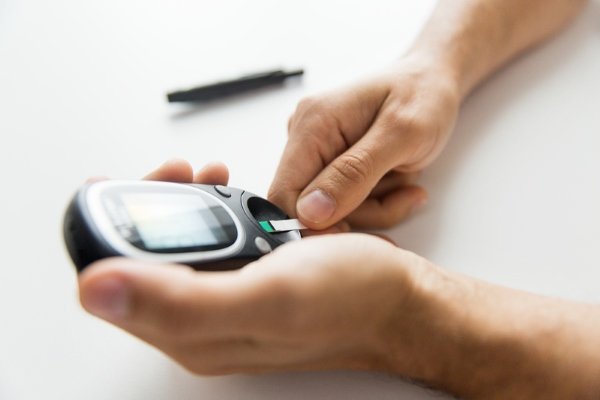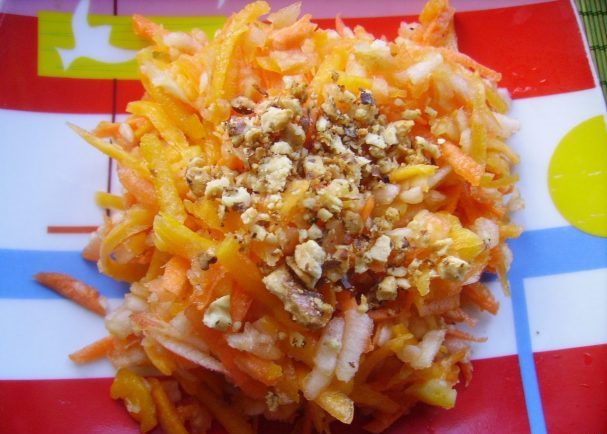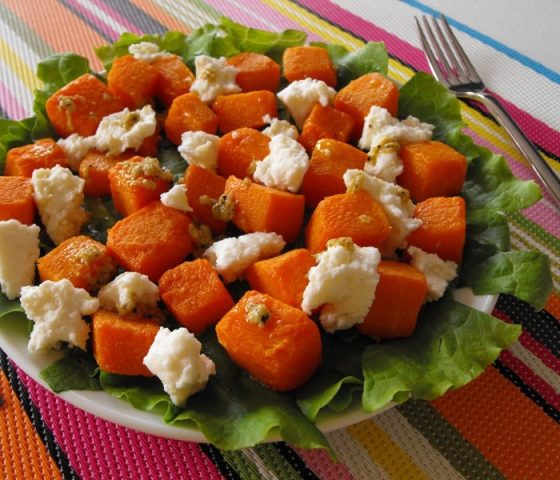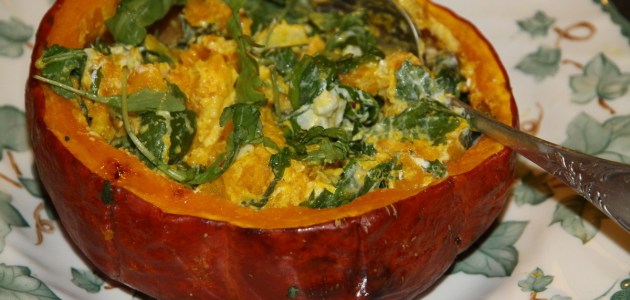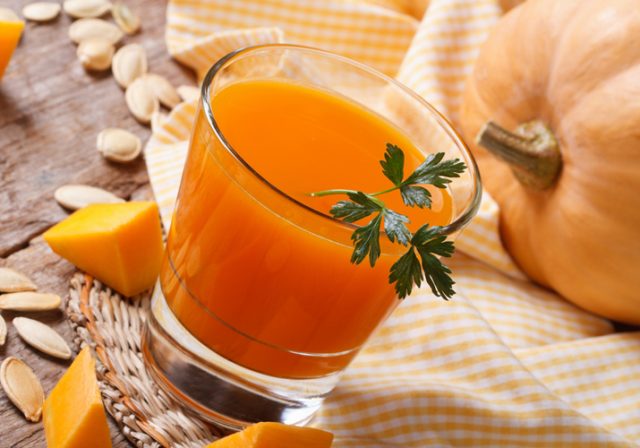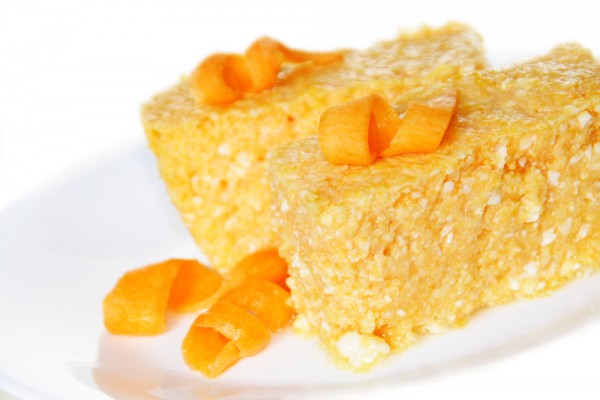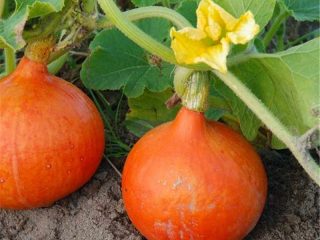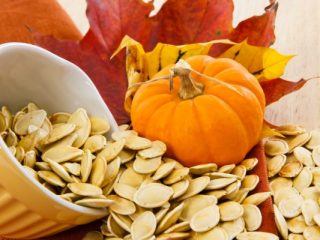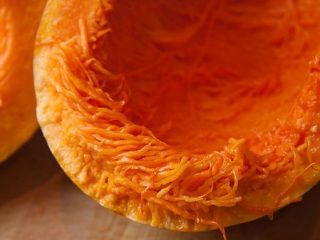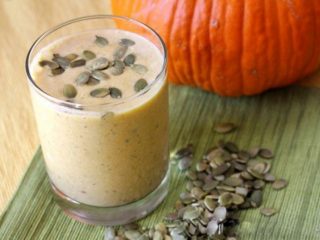Content
There are various pumpkin recipes for type 2 diabetics, with which you can diversify your diet menu. These are various types of salads, casseroles, cereals and other dishes. In order for pumpkin to bring maximum benefit to the body, it must be cooked at a gentle temperature, and even better, consumed raw.
Is it possible to eat pumpkin if you have diabetes?
For diabetes mellitus, pumpkin pulp is very useful in any form: raw, boiled, steamed. To obtain the most beneficial effect, it should be taken on an empty stomach, separately from other types of food.
The most beneficial for diabetics is raw vegetable. Its glycemic index is only 25 units. During the cooking process, this indicator can increase significantly, especially if there are accompanying ingredients in the recipe.For example, the GI of a boiled fruit is already 75 units, of a baked fruit - from 75 to 85 units.
Pumpkin prevents and alleviates the following diseases and conditions:
- heart rhythm disturbances;
- angina pectoris;
- hypertension;
- atherosclerosis;
- diseases of the kidneys, liver, pancreas;
- cataract;
- obesity;
- insomnia;
- prostration;
- anemia;
- swelling;
- infectious diseases.
The presence of a large amount of pectin, vitamins, as well as some microelements (Fe, K, Cu, Mg), makes it possible to successfully use pumpkin in the prevention and treatment of cardiovascular pathologies. Introducing vegetables into the daily menu:
- improves heart function;
- reduces cholesterol levels;
- normalizes blood pressure;
- increases the oxygen capacity of the blood;
- reduces swelling of the legs and abdominal cavity;
- improves the condition of atherosclerosis and cerebral ischemia.
The presence of organic acids and delicate fiber in the vegetable helps improve digestive processes. Strengthens the functions and motility of the intestines, gall bladder and ducts, stimulates the secretion of digestive juices by the stomach, intestines, as well as the pancreas and liver. The pulp of the vegetable is useful for colds and metabolic disorders. Every person with such a diagnosis should learn more about the benefits or harms of pumpkin for diabetics.
Benefits of pumpkin for diabetics
Pumpkin can be eaten by diabetics, as the vegetable has a positive effect on the pancreas, stimulating an increase in beta cells. Unique antioxidant properties help insulin secretion. Thanks to this, the lost functions of the gland are partially restored.
It is useful for diabetics to take the vegetable raw, limiting its quantity. The daily norm should be no more than 200-300 g.For greater safety and to obtain the desired effect, it must be divided into several techniques.
With low calorie content, the vegetable has high nutritional value. The energy value of 100 g of product is only 22 kcal. The vegetable is rich in potassium content. This allows the product to quickly relieve swelling and strengthen the cardiovascular system. The high beta-carotene content helps cope with eye and skin diseases.
For type 1 diabetes
The benefit of pumpkin for type 1 diabetes is that with regular use in food, its own insulin begins to be produced. As a result, blood sugar decreases. Thanks to pectin, water-salt metabolism improves, food is well absorbed, and excess fluid is removed from the body.
The pulp of the vegetable has a light enveloping property and protects the mucous membrane of the digestive organs from the appearance of ulcers and erosions. Promotes weight loss, which brings significant relief to patients with diabetes.
For type 2 diabetes
Pumpkin can be eaten if you have type 2 diabetes, as the vegetable contains few calories. As is known, the most common provoking factor for this disease is excess weight and obesity. The vegetable also has the ability to reduce glycemic levels. Fiber slows down the process of glucose absorption and release into the blood. Zinc contained in the vegetable helps the rapid healing of wounds and trophic ulcers in diabetes.
Pumpkin dishes for diabetics
You can prepare different dishes from pumpkin for diabetes. They are low in calories, nutritious, and easy to digest. Diabetics, when trying a new dish, need to measure their glycemic levels before and after. This way you can determine what the body’s reaction will be.
Pumpkin salads
As mentioned above, the vegetable is most useful in its raw form.It will “look” good in salads and vitamin cocktails.
Apple salad
Ingredients:
- pumpkin (pulp) – 200 g;
- apple – 120 g;
- carrots – 120 g;
- yogurt (unsweetened) – 100 g;
- Brazil nut – 50 g.
Peel fruits and vegetables and chop on a coarse grater. Add yogurt, stir. Sprinkle nut shavings on top.
Beetroot salad
Ingredients:
- pumpkin – 200 g;
- boiled beets – 200 g;
- vegetable oil – 30 ml;
- lemon juice – 20 ml;
- dill (greens) – 5 g;
- salt.
Coarsely grate the vegetables and season with a mixture of lemon juice and vegetable oil. Sprinkle with finely chopped dill and salt. Mix everything.
Salad with bell pepper and spinach
Ingredients:
- pumpkin – 200 g;
- bell pepper – 150 g;
- spinach – 50 g;
- kefir – 60 ml;
- salt.
Grind the pumpkin pulp, chop the pepper into half rings, finely chop the spinach. Combine all components and mix.
Stuffed and baked pumpkin
Pumpkin for type 2 diabetes is best cooked in the oven. The vegetable can be baked, stuffed with meat and other vegetables, rice, and cheese.
Pumpkin stuffed with turkey
Take one small elongated pumpkin, cut it in half, clean out the core. Sprinkle the inner walls with vegetable oil, pepper and salt. Bake for 20 minutes in the oven at +200 C. Next, prepare the filling. It will require the following ingredients:
- turkey breast – 300 g;
- onion – 1 pc.;
- carrots – 1 pc.;
- celery – 3 stalks;
- thyme – 1 tsp;
- rosemary – 1 tsp;
- garlic – 3 cloves;
- egg – 2 pcs.;
- salt;
- pepper.
Fry the turkey, cut into cubes. Also chop the onion, carrot, celery and simmer in oil in a frying pan, add spices and meat. Beat 2 eggs into the resulting mass, mix and place in pumpkin pots.Bake for another 20 minutes.
Pumpkin with peppers and onions
Cut the pumpkin pulp into thin slices and place in a baking dish. Pepper, salt, grease with oil. Chop the onion into half rings, season with spices, oil, and tomato sauce. Place on top of the pumpkin layer. Bake in the oven for about an hour.
Ingredients:
- pumpkin – 1 pc.;
- onion – 2 pcs.;
- pepper;
- salt;
- vegetable oil;
- tomato sauce.
For baked vegetables, you can prepare a sauce from sour cream, chopped herbs, and garlic. This will enhance the taste and nutritional properties of the dish.
pumpkin juice
Pumpkin juice for type 2 diabetes in moderation will be very useful. It is best to prepare it using a juicer. If you don’t have this at home, you can use a blender, grater, or meat grinder. Squeeze the crushed mushy pulp through cheesecloth. Drink the juice immediately, as it quickly loses its beneficial properties.
Pumpkin juice should not be diluted with mineral water; it is better if it is another fresh juice, for example, apple, carrot, or beet juice. Goes well with orange and lemon juice. You shouldn’t get too carried away, since the drink contains a fairly high concentration of glucose, which, due to the lack of fiber, immediately enters the bloodstream.
Porridge with pumpkin
The most useful cereals for diabetics are buckwheat and oatmeal. You can also cook millet and rice porridge. All these grains go well with vegetables. It is worth considering pumpkin dishes for type 2 diabetics.
Dish with buckwheat
Rinse the cereal and cover with water for 2.5 hours. Drain off any water that has not been absorbed. Peel the pumpkin and apple, bake separately in foil at +200 C until soft.
Ingredients:
- buckwheat – 80 g;
- water – 160 ml;
- pumpkin – 150 g;
- banana – 80 g;
- apple – 100 g;
- milk – 200 ml;
- cinnamon.
Pour milk over buckwheat, add cinnamon, fruit and vegetable filling. Bring to a boil and remove from heat.
Dish with millet
Peel the pumpkin, chop finely, rinse the millet. Pour everything into hot milk, add a little salt, and cook until tender. To let the porridge boil, put it in the oven for half an hour.
Ingredients:
- pumpkin – 0.5 kg;
- milk – 3 tbsp;
- millet – 1 tbsp.;
- salt;
- sucralose.
To make the porridge sweet, you need to use a sweetener, for example, sucralose. Pumpkin porridge for diabetics is also good to cook in a slow cooker.
Pumpkin casserole
You can cook cereal, meat, and cottage cheese casseroles with pumpkin. Recipes for some of them are discussed below.
Casserole with onions and minced meat
Ingredients:
- pumpkin – 300 g;
- onions – 3 pcs.;
- minced meat – 300 g;
- tomato sauce – 5 tsp.
Stew the minced meat together with the diced onion. Grate the pumpkin, let the excess liquid drain, add salt, and place in the mold. Next, lay down a layer of minced meat. Top with another layer of pumpkin, brush with tomato sauce. Bake for 45 minutes.
Casserole with millet and lemon
Pumpkin will make a delicious pudding that will be safe for diabetics and very useful for this disease.
Ingredients:
- pumpkin – 0.5 kg;
- millet – 1 tbsp.;
- water – 3 tbsp.;
- milk (warm) – 0.5 l;
- zest (lemon) - 3 tbsp. l.;
- zest (orange) – 3 tbsp. l.;
- cinnamon;
- sucralose.
Cut the peeled pumpkin into cubes. Rinse the millet with hot water and then boiling water. Place the vegetable in a cauldron, add water and bring to a boil, then add the cereal. Cook for about 6-7 minutes. Add the rest of the ingredients and cook under the lid for the same amount. Then cool.
How to treat trophic ulcers with pumpkin
In folk medicine, pumpkin is widely used to treat diabetes and its complications.Decoctions of vegetable flowers in pure form or mixed with other herbs are used to wash purulent wounds and trophic ulcers.
Recipe 1
2 tbsp. l. pour a cup of boiling water over the flowers and leave in a water bath for 10 minutes, and then for another half hour under the lid. Cool, strain, add boiled water to bring the volume to 300 ml. Apply lotions to the affected areas.
Recipe 2
Grind the raw fruit in a blender, meat grinder or fine grater. Apply the resulting pulp on a gauze bandage (napkin) to the affected areas and renew it every morning and evening.
Recipe 3
Cut the fruit into slices and dry in the oven at low temperatures to preserve the beneficial substances. Grind dry raw materials into powder. Sprinkle it on wounds and ulcers for diabetes. You can also use vegetable flowers.
Restrictions and contraindications
Raw pumpkin is contraindicated for ulcerative lesions of the gastrointestinal tract, gastritis with low acidity, as well as for severe diabetes mellitus. For patients with gastrointestinal diseases, it is better to use it boiled (steamed).
Conclusion
Pumpkin recipes for type 2 diabetics will help you prepare nutritious and healthy dishes that will maintain an optimal balance of nutrients in the body and improve metabolism. The vegetable will also have a healing effect on the body and will serve as an excellent prevention of many complications associated with diabetes.

